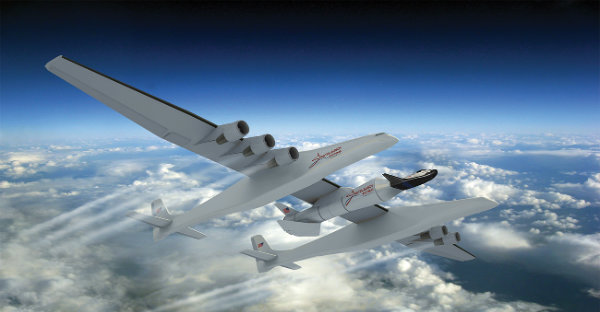Sierra Nevada on 30 September launched two bids to keep alive its Dream Chaser lifting body spaceplane project, which suffered a blow earlier in the month when NASA cut it from its Commercial Crew programme in favour of seven-person capsules being developed by Boeing and SpaceX.
The company has teamed up with Stratolaunch Systems to unveil a design for a three-crew version that could be launched horizontally to low Earth orbit (pictured). Stratolaunch is proposing to air-launch small spacecraft using a purpose-built, twin-fuselage carrier aircraft – an arrangement that resembles a large, six-engined version of Virgin Galactic’s WhiteKnightTwo.
Like the full-scale, seven-crew Dream Chaser, the air-launched version could also be used for unmanned missions.
Also on 30 September, the company presented to the International Astronautical Congress in Toronto its plan to offer Dream Chaser as a “baseline vehicle” for “an array of [low Earth orbit] missions to support government, commercial, academic and international goals”.
The proposals follow a legal challenge to NASA’s award of contracts to Boeing and SpaceX to deliver US astronauts to the International Space Station under its Commercial Crew Transportation Capability (CCtCap) programme. Sierra Nevada says while all three competitors were deemed capable of meeting the mission requirements, “one of [the chosen alternatives] would result in a substantial increased cost to the public”, and hence the government will be paying $900 million more than had it chosen Dream Chaser.
With the legal challenge pending, Sierra Nevada declines to comment on whether its non-selection would affect an agreement reached early in 2014 to partner with the European Space Agency and Germany’s DLR aerospace agency on spaceplane applications. Options believed to be under consideration include incorporating into a version of Dream Chaser re-entry technologies being developed by ESA through its own spaceplane programme, and even launching Dream Chaser atop Ariane 5 rockets from French Guiana.
Dream Chaser, derived from NASA’s HL-20 lifting body concept of the 1980s, is at a relatively advanced stage of development. Avionics and autonomous control were validated in 2013 in a drop test from 12,500ft. That craft was not shielded against re-entry heat but was essentially identical – in shape and size – to a version Sierra Nevada expects to fly atop an Atlas rocket in 2016, in fully autonomous mode, and then in 2017 with a human pilot.
ESA, meanwhile, is also taking seriously its first bid to develop a reusable spacecraft. A heavily instrumented 2t unmanned lifting body concept vehicle called IXV (Intermediate eXperimental Vehicle) is set for a suborbital flight by Vega rocket in mid-November. IXV’s large-panel thermal protection system – which has been extensively tested in the hypersonic Scirocco windtunnel near Naples – promises significant improvements over the small tiles that proved so problematic on NASA’s Space Shuttle.
But it is IXV’s follow-on programme, PRIDE (Programme for Reusable In-orbit Demonstrator in Europe), that may result in a fully orbital, runway-landing vehicle being used for orbiting small satellites, servicing satellites or conducting scientific missions. PRIDE is being sized to fit on ESA’s Vega rocket, and carries the legacy of the Hermes spaceplane project studied by France’s CNES space agency and ESA in the 1980s, as well as the NASA-ESA-DLR X-38 crew return vehicle concept, which was abandoned in 2002.

Source: FlightGlobal.com



















